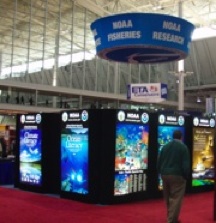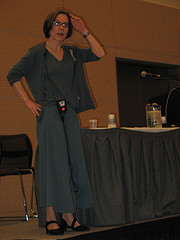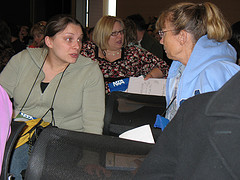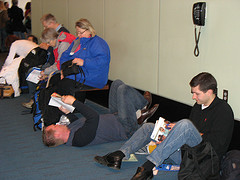New resources from NOAA
By Mary Bigelow
Posted on 2008-03-27
 I attended a session presented by some folks from NOAA called Data in the Classroom. No, it’s not about student assessments and NCLB! It’s about an effort to make the huge amount of data that NOAA has on the oceans and atmosphere accessible to students and teachers for problem solving and inquiry. Rather than just saying “Here is it is, have fun” they’ve created several modules (El Nino and Sea Level are ready now) that guide teachers and students through what they call “levels of scaled interaction.” In other words, each module has five levels of lessons ranging from teacher-presented ones through letting students explore the data to full-blown problem solving and invention. Each module shows the associated data in a variety of formats and guides the users through how to interpret it. There are “checkup” questions throughout, and teachers can download the materials. Even though the modules have been field tested, the NOAA folks are asking for additional feedback. (I played around a little this evening and my feedback is WOW). The address is www.dataintheclassroom.org
I attended a session presented by some folks from NOAA called Data in the Classroom. No, it’s not about student assessments and NCLB! It’s about an effort to make the huge amount of data that NOAA has on the oceans and atmosphere accessible to students and teachers for problem solving and inquiry. Rather than just saying “Here is it is, have fun” they’ve created several modules (El Nino and Sea Level are ready now) that guide teachers and students through what they call “levels of scaled interaction.” In other words, each module has five levels of lessons ranging from teacher-presented ones through letting students explore the data to full-blown problem solving and invention. Each module shows the associated data in a variety of formats and guides the users through how to interpret it. There are “checkup” questions throughout, and teachers can download the materials. Even though the modules have been field tested, the NOAA folks are asking for additional feedback. (I played around a little this evening and my feedback is WOW). The address is www.dataintheclassroom.org
If anyone has info on resources from other NOAA sessions, feel free to add a comment here and tell us about them.
 I attended a session presented by some folks from NOAA called Data in the Classroom. No, it’s not about student assessments and NCLB! It’s about an effort to make the huge amount of data that NOAA has on the oceans and atmosphere accessible to students and teachers for problem solving and inquiry.
I attended a session presented by some folks from NOAA called Data in the Classroom. No, it’s not about student assessments and NCLB! It’s about an effort to make the huge amount of data that NOAA has on the oceans and atmosphere accessible to students and teachers for problem solving and inquiry.
The power of data
By Debra Shapiro
Posted on 2008-03-27
 In her session on “Unleashing the Power of Data,” Nancy Love said cultural proficiency—knowing about and understanding different cultures—is key to interpreting data about science learning. “A child is not a number”—this fact is easy to forget when examining data, she observed.
In her session on “Unleashing the Power of Data,” Nancy Love said cultural proficiency—knowing about and understanding different cultures—is key to interpreting data about science learning. “A child is not a number”—this fact is easy to forget when examining data, she observed.
 Love used this image to illustrate the huge gap that can exist between data on student learning and interpretation of test results. “It’s our kids who are drowning in the middle,” she pointed out. Then she told us how to bridge the divide using collaborative inquiry.
Love used this image to illustrate the huge gap that can exist between data on student learning and interpretation of test results. “It’s our kids who are drowning in the middle,” she pointed out. Then she told us how to bridge the divide using collaborative inquiry.
 During the session, attendees had opportunities to talk with a nearby partner about how to look at data collaboratively.
During the session, attendees had opportunities to talk with a nearby partner about how to look at data collaboratively.
 In her session on “Unleashing the Power of Data,” Nancy Love said cultural proficiency—knowing about and understanding different cultures—is key to interpreting data about science learning. “A child is not a number”—this fact is easy to forget when examining data, she observed.
In her session on “Unleashing the Power of Data,” Nancy Love said cultural proficiency—knowing about and understanding different cultures—is key to interpreting data about science learning. “A child is not a number”—this fact is easy to forget when examining data, she observed.
Barbara Morgan—part 2
By Lynn Petrinjak
Posted on 2008-03-27
 Lynn here. I attended the general session this morning as well. I found Barbara’s speech particularly inspirational. As folks were leaving the ballroom, she announced she had a special presentation to make. She presented NSTA with momentos from her August flight aboard Endeavour—including a Christa McAuliffe flight patch. I was in high school at the time of the Challenger disaster, so I found this particularly moving.
Lynn here. I attended the general session this morning as well. I found Barbara’s speech particularly inspirational. As folks were leaving the ballroom, she announced she had a special presentation to make. She presented NSTA with momentos from her August flight aboard Endeavour—including a Christa McAuliffe flight patch. I was in high school at the time of the Challenger disaster, so I found this particularly moving.
I did want to add one note. During several sessions I’ve attended, I’ve heard cell phones going off. I found this disruptive, especially when a person sitting near me proceeded to carry on a conversation with the caller.
 Lynn here. I attended the general session this morning as well. I found Barbara’s speech particularly inspirational. As folks were leaving the ballroom, she announced she had a special presentation to make.
Lynn here. I attended the general session this morning as well. I found Barbara’s speech particularly inspirational. As folks were leaving the ballroom, she announced she had a special presentation to make.
Science fairs made easy
By Debra Shapiro
Posted on 2008-03-27
 Susan Morgan gave us tips for starting and running a science fair gleaned from her 18 years of experience with fairs. I appreciated her suggestion to let students choose something they’re interested in and develop a question to answer. Let them follow their own star.
Susan Morgan gave us tips for starting and running a science fair gleaned from her 18 years of experience with fairs. I appreciated her suggestion to let students choose something they’re interested in and develop a question to answer. Let them follow their own star.
Morgan (at left in the photo above) advised teachers to take time to chill out before the science fair. “You may only have three hours of happy hour before the fair–but enjoy it!”
 Susan Morgan gave us tips for starting and running a science fair gleaned from her 18 years of experience with fairs. I appreciated her suggestion to let students choose something they’re interested in and develop a question to answer. Let them follow their own star.
Susan Morgan gave us tips for starting and running a science fair gleaned from her 18 years of experience with fairs. I appreciated her suggestion to let students choose something they’re interested in and develop a question to answer. Let them follow their own star.
Barbara Morgan—exploring space through a teacher's eyes
By Mary Bigelow
Posted on 2008-03-27
Barbara Morgan was a featured speaker today, and it was a real thrill to see her in person. She described her Space Shuttle mission with slides and videos, a wonderful sense of humor, and a real pride in being an educator. As I listened to her describe what makes a NASA mission successful, several words and phrases came to mind: collaboration, teamwork, the importance of multiple roles, technology, using data and feedback, authentic experiences in training, guided practice, debriefing, a set of goals, communications, focused inspections, celebrations. Shouldn’t these words also describe a successful classroom?
Barbara Morgan was a featured speaker today, and it was a real thrill to see her in person. She described her Space Shuttle mission with slides and videos, a wonderful sense of humor, and a real pride in being an educator. As I listened to her describe what makes a NASA mission successful, several words and phrases came to mind: collaboration, teamwork, the importance of multiple roles, technology, using data and feedback, authentic experiences in training, guided practice, debriefing, a set of goals, communications, focused inspections, celebrations.
A home away from home
By Debra Shapiro
Posted on 2008-03-27
It’s amazing how comfortable you can be at an NSTA conference, even in a city you’ve never visited before. Even the floors are just like home! That guy lying down looks so peaceful, don’t you think?

It’s amazing how comfortable you can be at an NSTA conference, even in a city you’ve never visited before. Even the floors are just like home! That guy lying down looks so peaceful, don’t you think?

New conference features
By Mary Bigelow
Posted on 2008-03-27
 Just taking a break after a full schedule of sessions and a reconnaissance of the exhibitor’s hall. The conference center is a very large venue, but somehow it doesn’t seem as hectic as some. It even seemed that the registration area was running smoothly. There are lots of places to sit and relax, plan a schedule, chat with friends (I ran into one of my professors from grad school here!), or grab a snack. We teachers are used to eating in 10 minutes!
Just taking a break after a full schedule of sessions and a reconnaissance of the exhibitor’s hall. The conference center is a very large venue, but somehow it doesn’t seem as hectic as some. It even seemed that the registration area was running smoothly. There are lots of places to sit and relax, plan a schedule, chat with friends (I ran into one of my professors from grad school here!), or grab a snack. We teachers are used to eating in 10 minutes!
One wonderful feature of the new Boston Convention and Exhibition Center is that there is wireless service throughout the whole building! I was in a session earlier that mentioned a website, and right after the session I could take a look at it. The presenters, I’m sure, appreciated the fact that they did not have to pay extra for Internet access.
Another cool feature is NSTA’s Professional Development documentation project. Many conferences have agreements with local universities to provide graduate credit for conference attendance (as this conference does), but NSTA is providing another option for those who need to document their attendance. If attendees complete a session evaluation form and include their names and badge numbers, in a few weeks NSTA will have a “transcript” available online with the names of the sessions and the times. So we don’t have to keep a diary or try to remember what we did when we get home. By going to the NSTA website, attendees can get this documentation to share with their schools or for their personal records.
NSTA conference in Boston
By Mary Bigelow
Posted on 2008-03-27
Be sure to check out the conference blog this week. Use the tab at the top of the page for first-hand accounts of the sessions, exhibitors, speakers, and the overall impressions of being a national conference!
Be sure to check out the conference blog this week. Use the tab at the top of the page for first-hand accounts of the sessions, exhibitors, speakers, and the overall impressions of being a national conference!
Just how big is this conference?
By Mary Bigelow
Posted on 2008-03-26
 According to the NSTA conference website, there are over 1400 presentations and workshops (not counting other special sessions and happenings)! I was finding it hard to visualize this until this evening when I picked up my hard copy of the conference program (I should say programs – plural). There are four volumes, one for the events on Thursday, Friday, and Saturday/Sunday, plus another volume devoted to the exhibitors! The events are arranged by time slot, but they are also cross-referenced by subject and conference strand. There’s also a list of presenters, so you can look for someone in particular (and it’s really a thrill to see your own name there!). I can’t imagine all of the work that goes into organizing a conference of this size. I’m going to settle in now and pick out what I want to see tomorrow. So many topics and so little time!
According to the NSTA conference website, there are over 1400 presentations and workshops (not counting other special sessions and happenings)! I was finding it hard to visualize this until this evening when I picked up my hard copy of the conference program (I should say programs – plural). There are four volumes, one for the events on Thursday, Friday, and Saturday/Sunday, plus another volume devoted to the exhibitors! The events are arranged by time slot, but they are also cross-referenced by subject and conference strand. There’s also a list of presenters, so you can look for someone in particular (and it’s really a thrill to see your own name there!). I can’t imagine all of the work that goes into organizing a conference of this size. I’m going to settle in now and pick out what I want to see tomorrow. So many topics and so little time!
 According to the NSTA conference website, there are over 1400 presentations and workshops (not counting other special sessions and happenings)! I was finding it hard to visualize this until this evening when I picked up my hard copy of the conference program (I should say programs – plural).
According to the NSTA conference website, there are over 1400 presentations and workshops (not counting other special sessions and happenings)! I was finding it hard to visualize this until this evening when I picked up my hard copy of the conference program (I should say programs – plural).
Making science relevant
By Mary Bigelow
Posted on 2008-03-19
 Why are we studying this? What good will this do me? I know there are teachers who enjoy the challenge of students’ asking questions such as these and others who consider these questions to be disrespectful or distracting (and from some students they may be!). But I must confess that I was a questioner in school. If we were studying a new topic or doing an activity, I needed to know what the point was. It really didn’t matter to me what the teacher said the point was, as long as I could see that there was a point, beyond getting a grade or doing something for a test. And, regardless of the subject, if the point involved anything creative, I was hooked!
Why are we studying this? What good will this do me? I know there are teachers who enjoy the challenge of students’ asking questions such as these and others who consider these questions to be disrespectful or distracting (and from some students they may be!). But I must confess that I was a questioner in school. If we were studying a new topic or doing an activity, I needed to know what the point was. It really didn’t matter to me what the teacher said the point was, as long as I could see that there was a point, beyond getting a grade or doing something for a test. And, regardless of the subject, if the point involved anything creative, I was hooked!
Some students find topics in science to be inherently interesting. The teacher could read from a textbook, and these students would still be interested. But for other students, teachers need to help students to see how the content is relevant. And even if students aren’t particularly interested in a topic (my own high school economics class comes to mind), the teacher can hook the students with personal anecdotes, interesting questions, cooperative activities, hands-on projects, trade books, or multimedia. The focus of this issue of Science Scope is on how to make science relevant.
The article Volcano Resumes shows how students can be engaged by a new twist on the typical “report.” In addition to the websites suggested by the author, the SciLinks keywords volcano or ring of fire can help students get started on their websearch. Students could also use websites to find volcano pictures for the resumes. And if the students would plot the coordinates on a map, they could see the “ring of fire” concept.
Who hasn’t an idea for an invention? I saw a quote today that said “If necessity is the mother of invention, laziness is the grandmother.” Middle-schoolers may relate to that! Problem Solving with Patents adds another dimension to the topic of inventions by looking at the patent process. Go to SciLinks and enter the keyword inventor to look at the inventive process through websites such as Invention Dimension from MIT with a searchable archive of inventors and a handbook for patenting an invention. You can also use the keywords Alexander Graham Bell or Thomas Edison for sites on these important inventors.
For information related to Bumpy, Sticky, and Shaky: Nanoscale Science and the Curriculum use nanoscience as keyword in SciLinks. Two of sites in this topic could be of interest to students: Introduction to Nanotechnology and Nanokids.
Investigating your own neighborhood and reporting the observations to a national database can be both relevant and authentic (two buzzwords in one sentence!). In addition to the projects described in Wanted: Citizen Scientists (Project Feederwatch, Bird Sleuth, and Monarch Watch), I recently heard of Project BudBurst, in which students, gardeners, and other interested folks observe flowering plants in their gardens, schoolyards, and lawns and then enter the observations into a national database to help scientists study the effects of climate change through the timing of flowers and foliage. The site has lots of ideas and resources (use the “Participate” link to get to the teacher resources).
Going on a Science Trek shows how students can demonstrate what they are learning in creative ways. I’ve seen a lot of lessons where the objective stated that the “students will be able to create a PowerPoint” (or diorama, poster, report). But in a science course, creating a report or exhibit is not really the objective. The PowerPoint, diorama, report, or poster is a way for students to communicate what science concepts they are learning. And this article makes this point with lots of ideas! What can be more relevant than providing many ways for students to use their creativity to solve a problem and communicate the results?
 Why are we studying this? What good will this do me? I know there are teachers who enjoy the challenge of students’ asking questions such as these and others who consider these questions to be disrespectful or distracting (and from some students they may be!). But I must confess that I was a questioner in school. If we were studying a new topic or doing an activity, I needed to know what the point was.
Why are we studying this? What good will this do me? I know there are teachers who enjoy the challenge of students’ asking questions such as these and others who consider these questions to be disrespectful or distracting (and from some students they may be!). But I must confess that I was a questioner in school. If we were studying a new topic or doing an activity, I needed to know what the point was.


